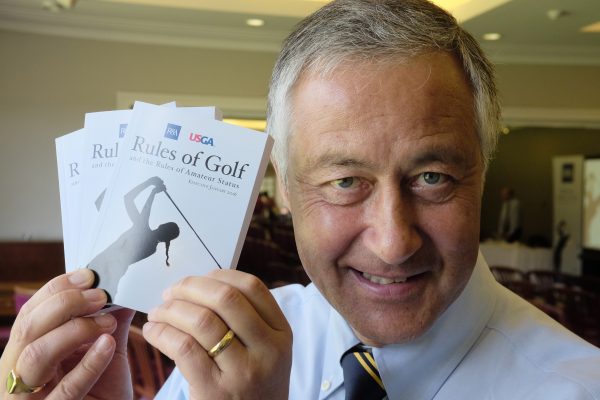
The R&A and the USGA announced the publication of the 2016 Rules of golf on 26 October. Details of the announcement and the full text of the new Rules can be accessed from the home page of their relevant web sites (www.randa.org and www.usga.org ). The new Decisions are also available in PDF format on these sites. In this article I will summarise the key changes and the effect they will have on your playing of the game.
Ball Moving After Address
At present under Rule 18-2b, if you address the ball and it subsequently moves you are automatically deemed to have caused the ball to move and will incur a penalty of one stroke and must replace the ball. In 2012, a tight exception was introduced covering situations such as the wind moving the ball, in which case there is no penalty and the ball is played as it lies.
Rule 18-2b has been withdrawn from the new code and if your ball moves after you address it, the question that must be answered is, did you cause the ball the move? If the answer is yes, you incur the penalty stroke and must replace the ball; if the answer is no, there is no penalty and you play the ball from its new position.
If it is unclear what caused the ball to move, there is a new Decision (18-2/0.5) which gives guidelines to Committees to assist them in making a ruling based on all relevant information and the weight of evidence.
Incorrect Score Card
Currently, if you return a score for any hole lower than actually taken for any reason, you are disqualified.
A limited exception has been added in the new code stating that, if the only reason you returned the lower score is that you failed to include a penalty stroke/s you did not know that you had incurred, you will no longer be disqualified. However, your score will be amended to add the penalty under the Rule that was breached plus an additional penalty of two strokes for the score card error.
For example, if you failed to mark your ball in the rough before lifting it for identification on the fourth hole and failed to include the penalty stroke in your score for that hole, the score for that hole is amended by adding the penalty stroke and an additional two penalty strokes (three penalty strokes in total). In a stableford competition the one-stroke penalty for failing to mark the ball would be added to your score for the fourth hole, but the additional penalty of two strokes is applied by deducting two points from your total score for the round.
Artificial Devices or Equipment
A breach of Rule 14-3 currently attracts a penalty of disqualification. You would be in breach of this Rule if, for example, you use a training or swing aid such as an alignment rod or a weighted headcover during the round.
Under the revised Rule, the first use of such a device would only attract a penalty of two strokes in stroke play or loss-of-hole in match play rather than disqualification. The penalty for a subsequent breach, however, will continue to be disqualification.
Distance-Measuring Device Local Rule
Under the current Local Rule for distance-measuring devices, you are in breach of the Local Rule if you use a device which has any non-conforming features on it (such as the ability to measure slope, wind speed or temperature or to provide advice on club selection) even if the feature is not accessed or used during the round.
Under the new Local Rule you would only be penalised if you actually use the non-conforming feature itself.
Please note that distance measuring devices may only be used in competitions where the local rule is in effect.
Prohibition on Anchoring
The prohibition on anchoring the club while making a stroke was announced in May, 2013 well in advance of the Rule change.
Under new Rule 14-1b, you may not anchor the club either “directly” or by use of an “anchor point.” The new Rule applies to all levels of golf, including amateur competitions, social golf and professional golf.
Note that there is no prohibition on the use of long putters or belly putters. Any currently conforming club can be used. The club must not be directly anchored to the body with the club or the gripping hand, or by creating an anchor point. So, if you continue to use your long putter, it is simply a matter of taking the gripping hand away from the body during the stroke.
The R&A and USGA websites provide detailed advice on the various methods of gripping a club which are allowed and prohibited under the new Rule. The R&A’s guidance document to assist committees with the implementation of the new Rule is also available on the Golf Australia website – www.golf.org.au/randaanchoringdocument.
Rules Clarifications
The above amendments are by no means the only changes to the Rules to take effect on 1 January, 2016.
The following are a couple of less significant but very helpful amendments.
Rule 26-2
This rather complicated Rule (even for referees) deals with the situation where your ball is played from a water hazard, but you either fail to extract it from the hazard or it comes to rest out of bounds or in an unplayable position outside the hazard.
The Rule has been restructured to make it easier to understand the options available under the Rule.
Rule 3-3
This Rule allows you to play a second ball in stroke play if you are doubtful of your options. The essence of the Rule has not changed, but it has been restructured for clarity.
The Rule is now split into two sections. Rule 33-a deals specifically with the options and procedures available to the player. Rule 33-b provides guidance to the Committee on how to determine the player’s score.
You will notice when you receive your copy of the new Rule Book that, unlike in previous editions, there is no end date. The cover simply states “Effective January 2016.”
The governing bodies are currently undertaking an extensive review of the rules with the aim of significantly simplifying them and modernising the language used. This new revision may take effect prior to the usual cycle of four years.




![Win the golfing experience of a lifetime, at the Hawai‘i International Week of Golf, valued at $6,900 [Winner Announced] Win the golfing experience of a lifetime, at the Hawai‘i International Week of Golf, valued at $6,900 [Winner Announced]](https://www.insidegolf.com.au/wp-content/uploads/Hawaii-Comp-500x294.jpg)